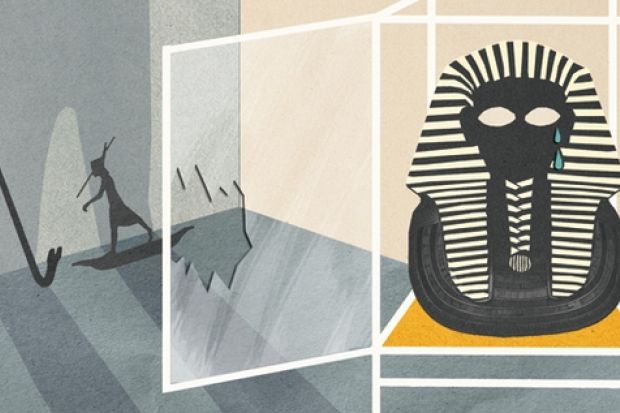Three gilded wooden statues of Tutankhamen are among the objects reported to be damaged or missing from the Egyptian Museum in Tahrir Square, following an alleged break-in on the night of 28 January. Reports from Cairo have been uneven - several objects have been listed as broken, then fine, then missing, then found - but given the circumstances in Egypt these past weeks, that's not so surprising.
What is surprising is the response from the academic community, which has focused on objects rather than politics, as if the two can be separated. "Heartbreaking", "a catastrophe", "shameful", laments the blogosphere - but with little mention of protests or people, much less the history of Western involvement in Egyptian archaeology.
This is not the first time the tomb of Tutankhamen has been caught up in a revolution. In 1919, hundreds of Egyptians died in public uprisings that formed part of an anti-colonial movement that resulted in Britain granting Egypt formal independence in 1922. That same year, Howard Carter discovered Tutankhamen's tomb. Soon thereafter, the new government, under former dissident Sa'd Zaghlul, adopted Tutankhamen as a nationalist symbol. Bitterly disappointed by this turn of events, Carter unsuccessfully sued to contest state ownership of the tomb contents, which he had hoped would be split between the Cairo museum and his sponsor, Lord Carnarvon.
Archaeology, museums and heritage have always been political. Like anthropological fieldwork and leisure tourism, excavations were made possible by colonial infrastructures, from railways and banks to research institutes and museums.
Although its name has changed (to the Supreme Council of Antiquities), the Egyptian antiquities service has much the same form as when the French set up and ran it, complete with a journal called the Annales du Service des Antiquités de l'Egypte.
The UK's leading Egyptology organisation, the Egypt Exploration Fund (now the Egypt Exploration Society), was founded in 1882, coinciding with Britain's military occupation of the country; a storage magazine at Dahshur that has just been burgled is still called De Morgan's, more than a century after the French archaeologist Jacques de Morgan worked there.
And the Egyptian Museum, home to the Tutankhamen finds? Opened in its current location in 1902, this pink-and-white Beaux Arts building is a monument to the Egyptian past - but not the ancient past. The winning design, by a French architect, was chosen from a shortlist of European entrants, judged by Europeans. On the facade, oversized Latin plaques name the founding fathers of Egyptology (Europeans, yes), and in the grounds, the Mariette Monument contains the ashes of the Frenchman who established the Service des Antiquités.
Egyptology websites, discussion lists, even Facebook groups have circulated updates about suspected looting, and several organisations have issued statements calling for the protection of Egypt's antiquities. Ironically, such statements come on the heels of vigorous US and European rejections of Egyptian requests to repatriate objects, including some granted to foreign excavators before the 1920s.
For instance, not long before the protests began, Egyptian authorities contacted the current Earl of Carnarvon about several objects possibly linked to Tutankhamen that are in the family's collection at Highclere Castle.
Without taking into account this past, and the ancient one as well, calls to "save" Egyptian cultural heritage sound hollow at best.
Being blind to the past's effect on the present (and vice versa) should be quite a hindrance in a field based on close scrutiny of its chosen objects of study. But what has not been said about the splintered Tutankhamen statues speaks volumes: not only is this not their first revolution, it is not even the first time someone has interfered with them.
Each statue was dressed in finely woven linen when Carter found it, and had been placed in a wooden shrine with bolted doors. In ancient Egypt, statues embodied the divine and were kept wrapped up and shut away, handled only by priests. Archaeologists opened the shrines, discarded the linen and put the statues on display. In effect, they have been desecrated twice over - first stripped of their clothes and shrines to stand in a museum, and most recently wrenched from the modern sanctity of the display case.
Desecration reveals where power lies, and power is what is at stake in the wrangling over artefacts, then as now. Egyptology - or any discipline, for that matter - ignores history at its peril, especially its own.
Register to continue
Why register?
- Registration is free and only takes a moment
- Once registered, you can read 3 articles a month
- Sign up for our newsletter
Subscribe
Or subscribe for unlimited access to:
- Unlimited access to news, views, insights & reviews
- Digital editions
- Digital access to THE’s university and college rankings analysis
Already registered or a current subscriber? Login
